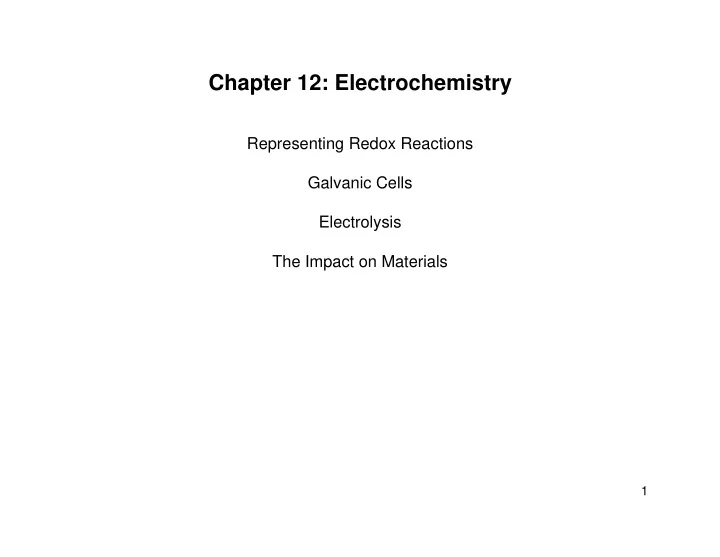

Chapter 12: Electrochemistry Representing Redox Reactions Galvanic Cells Electrolysis The Impact on Materials 1
Oxidation Number Review from Section K.2 of your Book 1. The oxidation number (ON) of an element uncombined with another element is zero: Na(s), C(gr), H 2 (g), I(s) … 2. For monoatomic ions, the charge is the ON: Na + ON = +1 3. The ONs of elements in group 1 equal 1 (ex. Lithium ON = +1) ONs of elements in group 2 equal 2 (ex. Magnesium ON = +2) 4. The ON of fluorine is always -1 in compounds. 5. The ON of the other elements in group 7 usually equals -1 6. The oxidation number of oxygen is usually -2 in compounds. Exceptions are fluorine compounds and peroxides 7. Hydrogen's ON is +1 when combine with non metals and -1 when combine with metals 8. The sum of the ONs of all the atoms in a species is equal to its total 2 charge
Oxidation Number Examples H 2 S ON H = +1 Bonded to a non metal ON S = -2 Total charge must equal O (2(1)-2 = 0) P 4 O 6 ON O = -2 Not bonded to F or forming a peroxide ON P = 3 Total charge must equal O (4(3)-6(2) = 0) - NO 3 ON O = -2 Not bonded to F or forming a peroxide ON N = 5 Total charge must equal -1 (5-3(2) = -1) 3
4 Electroplating
5 Corrosion
Corrosion O 2 (g) + 4H + (aq) +4e - � 2H 2 O(l) E o = 0.82 V -E o = 0.44 V 2Fe(s) � 2Fe 2+ (aq) + 4e - 2Fe(s) + O 2 (g) + 4H + (aq) � 2Fe 2+ (aq) + 2H 2 O(l) E o = 1.26 V ½ O 2 (g) + 2H + (aq) +2e - � H 2 O(l) E o = 0.82 V -E o = -0.77 V 2Fe 2+ (aq) � 2Fe 3+ (aq) + 2e - 2Fe 2+ (s) + ½O 2 (g) + 2H + (aq) � 2Fe 3+ (aq) + H 2 O(l) E o = 0.05V 4H 2 O(l) + 2Fe 3+ (aq) � 6H + (aq) + Fe 2 O 3 · H 2 O(s) 6 Overall Reaction : 2Fe(s) + 3/2O 2 (g) + H 2 O(l) � Fe 2 O 3 · H 2 O(s)
Primary Cells Galvanic cell with the reactants sealed inside at the manufacture. They can not be recharged Type Dry Cell Alkaline Cell Silver Cell (1.6 V) (1.5 V) (1.6 V) (emf) Longer Lasting Medical Uses Disposable Batteries Disposable Batteries Implants Anode Zinc Zinc Zinc Cathode Carbon Carbon Ag 2 O Electrolyte MnO 2 + Carbon Black + NH 4 Cl Alkaline Electrolyte KOH The interior of the container is The zinc only reacts lined with paper that serves as The batteries with the electrolyte Other the porous barrier. The are very when the battery is ammonia forms the complex reliable over Information being used Zn(NH 3 ) 4+ with the Zn 2+ ions and time (longer life) prevents their buildup. 7
Secondary Cells Galvanic cell that must be charged before they can be used. They usually can be recharged Type Lead-acid Sodium Sulfur (12 V) (2.2 V) (emf) Uses Car Batteries Power Electric Vehicles Lead-antimony alloy grid with lead (II) sulfate past on it Anode Molten Na (l) (during the first charging some of the lead (II) sulfate is reduced to lead) Lead-antimony alloy grid with lead (II) sulfate past on it Cathode (during the first charge some of the Molten S (l) lead (II) sulfate is oxidized to lead (IV) oxide) Electrolyte Dilute sulfuric acid Solid porous aluminum The battery can generate large amounts Needs temperatures above Other of current for short periods, such as the 320ºC to keep Na and S Information time needed to start an engine. molten. 8
Dry Cell Lead-Acid Cell Grids are made of a lead-antimony alloy that are covered in lead(II) Sulfate 9
Recommend
More recommend